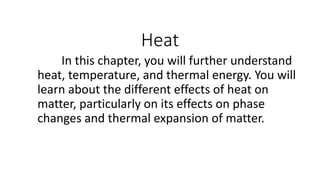
4. Heat.pptx
- 1. Heat In this chapter, you will further understand heat, temperature, and thermal energy. You will learn about the different effects of heat on matter, particularly on its effects on phase changes and thermal expansion of matter.
- 2. Whenever you use the thermometer to take your temperature, why do you have to wait for a few minutes before you check its reading? Temperature is the average kinetic energy of a system. For example, when you boil water, the particles of the water would have different kinetic energies. The kinetic energy of the particles near the source of the heat is different from the kinetic energy of the particles near the surface. So, to get the temperature of the water you need to know the average kinetic energy of all the particles. This also means that the number of particles does not affect the temperature of a system. So, what happens when we sum up all the kinetic energies and potential energies of a system? We get the thermal energy of the system.
- 3. Internal energy – refers to the total amount of kinetic energy and potential energy in the system. Thermal energy – it is the total energy of the system responsible for its temperature.
- 4. Thermal energy depends on the amount of the substance. The greater the amount of the substance, the greater the thermal energy. Temperature is the average kinetic energy in a system. So, it does not depend on the amount of substance.
- 5. Unlike temperature, thermal energy depends on the amount of matter. This means that the more particles a system has, the more thermal energy it possesses. So, a 500 mL water at 70 °C has more thermal energy than a 100 mL water with the same temperature. Temperature can be measured in Celsius, Fahrenheit, kelvin, and Rankine (relating to an absolute-temperature scale on which the unit of measurement equals a Fahrenheit degree and on which the freezing point of water is 491.67° and the boiling point 671.67). The Philippines and other Asian countries use degrees Celsius. In other countries, they use degrees Fahrenheit. Kelvin on the other hand is the SI unit of temperature. If two bodies with different temperatures come in contact with each other, you will notice that they will eventually end up with the same temperature.
- 6. Heat is defined as energy transit. It is a type of energy that transfers from one body to another whether there is a difference in temperatures. Heat is measured in joules (J). If there is no temperature difference, there will be no heat transfer. Hotter objects tend to give off heat. Heat flows from hotter bodies or objects to colder ones. If you hold an ice cube with your bare hand, the heat from your hand transfers to the ice cube causing it to melt. The transfer of heat from your hand makes your hand feels cold.
- 7. If there is no temperature difference there will be no heat transfer. Hotter objects stops from giving off heat when both objects reach thermal equilibrium. The first object is initially at 0°C, and the other is at 100 °C. when the two objects are placed in contact with each other in a closed system, the final temperature becomes 50 °C. Anders Celsius- is a Swedish astronomer from Uppsala, Sweden. He invented a temperature scale that was named after him- the Celsius. This temperature scale is also known as the centigrade scale. Under the Celsius scale, the freezing point of water is 0 °C, and its boiling point is 100 °C.
- 8. Five Phases of Matter 1. Solid 2. Liquid 3. Gas 4. Plasma 5. Bose-Einstein condensate During a phase change, the temperature of a system remains constant. This means that the added heat to the system is used to change the phase of the system and not to increase its temperature. If a solid is converted directly to gas without passing the liquid phase it is called sublimation. If a gas is converted directly to a solid without passing the liquid phase, it is called deposition.
- 10. Quiz 2.3 - Heat Direction: Choose the letter of the correct answer. 1. It is the average kinetic energy of a system. A.) Degrees B.) Celsius C.) Temperature D.) Kelvin Ans. C 2. It refers to the total amount of kinetic energy and potential energy in the system. A.) Internal Energy C.)Kinetic Energy B.) Thermal Energy D.) Ohm’s law
- 11. 3. It is the total energy of the system responsible for its temperature. A.) Internal Energy C.) Kinetic Energy B.) Thermal Energy D.) Ohm’s law Ans a. . B 4. It depends on the amount of the substance. A.) Internal Energy C.) Kinetic Energy B.) Thermal Energy D.) Ohm’s law Ans. B
- 12. 5. It is defined as energy in transit. A.) Heat C.) Temperature B.) Joules D.) Energy Ans. A 6. Heat is measured in ______. A.) Newton C.) Joules B.) Degrees D.) Celsius Ans. C.
- 13. Ans. C. 7. What is the freezing point of water? A.) 90°C B.) 80°C C.) 100°C D.) 0°C Ans. D 8. What is the boiling point of water? A.) 0°C B.) 90°C C.) 100°C D.) 50°CAns. C
- 14. 9. If a solid is converted directly to gas without passing the liquid phase it is called _______. A.) Preposition C.) Disposition B.) Sublimation D.) Absorption Ans.B 10. If a gas is converted directly to a solid without passing the liquid phase, it is called ________. A.) Preposition C.) Deposition B.) Sublimation D.) Absorption Ans.C
- 15. Give the five STATES/PHASES of MATTER 11. Solid 12. Liquid 13. Gas 14. Plasma 15. Bose-Einstein condensate